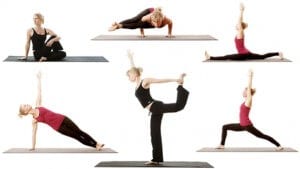Yoga Poses And How The Practice Benefits
Blue indicates link

Benefits of Doing Yoga:
1) Yoga is believed to reduce menopausal hot flashes.
2) Yoga improves your balance.
3) Yoga makes your moves more graceful.
4) Yoga can actually prevent you from having migraine headaches.
5) Yoga delays aging by stimulating Detoxification in the body.
6) Yoga can relieve constipation.
7) Yoga can alleviate allergy symptoms.
9) Yoga can increase your pain tolerance.
10) Yoga reduces blood pressure and pulse rate.
11) Yoga helps prevent disease by massaging, your internal organs
12) Yoga can help improve your immune system.
13) Yoga can heal the body and prevent injuries
14) Yoga improves your posture.
Using brain scans, scientists can now prove that yoga actually changes your brain chemistry. And that’s a good thing. Just like practicing tai chi moves, using yoga as a form of exercise and meditation can help naturally treat a range of health issues, particularly ones rooted in the brain. While natural therapies, including yoga, don’t have a ton of funding for major studies compared to the pharmaceutical and biotech industries, we are starting to see some compelling science emerge. Some of the best science to date showing how yoga changes your brain involves yoga’s impact on anxiety, depression, and pain tolerance.
Did you know yoga is a natural remedy for anxiety?
That’s because yoga impacts our brain’s GABA levels. GABA is short for gamma-aminobutyric acid, sometimes referred to as your body’s “chill out” neurotransmitter. GABA is crucial for suppressing neural activity. Your GABA neurotransmitters produce a calming effect similar to drinking alcohol (without the harmful side effects). And, of course, alcohol’s calming effects are only temporary, with anxiety often rising once the buzz wears off. Yoga bumps up your brain’s natural GABA production without traditional anti-anxiety drugs designed to help your body release GABA. (Getting off benzodiazepine drugs can lead to serious withdrawal symptoms.) Yoga sounds much better than insomnia, seizures, and, ironically, more anxiety linked with drug withdrawal.
Bring on the asanas! While walking to lose weight really works, it may not be your best defense against anxiety. Practicing yoga unleashes more anxiety-quelling GABA in the brain’s thalamus than walking, according to a 2010 study published in the Journal of Alternative and Complementary Medicine. Compared to pleasure reading for an hour, a 60-minute yoga session increases GABA levels by 27 percent. Because of its combination of breathing, meditation, and movement, yoga could be one of the best exercises to combat anxiety.



The links between Tai-chi and Yoga:
Tai Chi and yoga are like fitness cousins.
What is Tai-chi?
Both tai-chi and Yoga go very, very deep but you have to be willing to take the practice seriously. If you want to do it half-baked, then that’s the level of success you will have. If you want to feel like you’ve had a bit of a workout right away, you’ll get that from yoga. tai-chi can provide a lot of physical training but approaches it differently.
At a yoga class, you’ll most likely sweat and feel like you’ve done something physical in your first lesson – with tai-chi, it will start a bit more subtle. I have looked at many of the other answers here and elsewhere and it seems everyone is forgetting that tai-chi is a martial art, yoga is not.
When both of these practices are incorporated into each they supplement each other.
Though tai-chi is focused more on martial arts, having the knowledge of yoga and the flexibility it provides helps these two forms complement each other.
Once tai chi and yoga are broken down individually, it’s safe to say, they’re almost identical in benefits and components. The main difference is in execution. Yoga involves holding poses and postures. Tai chi is performed in a dance-like, martial arts form.







Amazon Shopping
Comments are always welcome.
Thank you,
Michael

